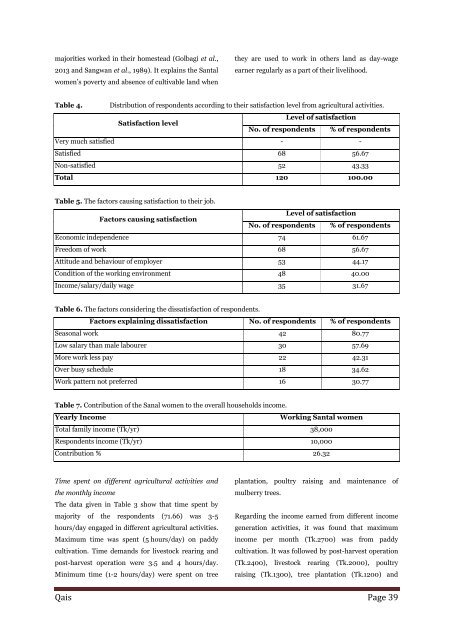Study on the agricultural activities of Santal women along the Barind tract of Bangladesh
The study was carried out to explore the different agricultural activities of the Santal women and their pattern of satisfaction and dissatisfaction, being involved in the job. It was undertaken in Rajshahi, which infact represents the greater area of Barind tract of Bangladesh. A sample of 120 Santal women engaged in different agricultural activities were selected by using random sampling method. The study revealed that the common agricultural activities were paddy cultivation, post-harvest operations, livestock rearing, poultry raising, maintenance of mulberry trees and tree plantation. The economic independence, freedom of work and condition of the working environment were the major factors, causing satisfaction to the Santal women. The main factors contributing to the dissatisfaction were the non-availability of permanent work throughout the year (seasonal work) low salary than the male labourer and more work less pay and lack of time for rest.
The study was carried out to explore the different agricultural activities of the Santal women and their pattern of satisfaction and dissatisfaction, being involved in the job. It was undertaken in Rajshahi, which infact represents
the greater area of Barind tract of Bangladesh. A sample of 120 Santal women engaged in different agricultural activities were selected by using random sampling method. The study revealed that the common agricultural
activities were paddy cultivation, post-harvest operations, livestock rearing, poultry raising, maintenance of mulberry trees and tree plantation. The economic independence, freedom of work and condition of the working
environment were the major factors, causing satisfaction to the Santal women. The main factors contributing to the dissatisfaction were the non-availability of permanent work throughout the year (seasonal work) low salary than the male labourer and more work less pay and lack of time for rest.
You also want an ePaper? Increase the reach of your titles
YUMPU automatically turns print PDFs into web optimized ePapers that Google loves.
majorities worked in <strong>the</strong>ir homestead (Golbagi et al.,<br />
2013 and Sangwan et al., 1989). It explains <strong>the</strong> <strong>Santal</strong><br />
<strong>women</strong>’s poverty and absence <strong>of</strong> cultivable land when<br />
<strong>the</strong>y are used to work in o<strong>the</strong>rs land as day-wage<br />
earner regularly as a part <strong>of</strong> <strong>the</strong>ir livelihood.<br />
Table 4. Distributi<strong>on</strong> <strong>of</strong> resp<strong>on</strong>dents according to <strong>the</strong>ir satisfacti<strong>on</strong> level from <strong>agricultural</strong> <strong>activities</strong>.<br />
Level <strong>of</strong> satisfacti<strong>on</strong><br />
Satisfacti<strong>on</strong> level<br />
No. <strong>of</strong> resp<strong>on</strong>dents % <strong>of</strong> resp<strong>on</strong>dents<br />
Very much satisfied - -<br />
Satisfied 68 56.67<br />
N<strong>on</strong>-satisfied 52 43.33<br />
Total 120 100.00<br />
Table 5. The factors causing satisfacti<strong>on</strong> to <strong>the</strong>ir job.<br />
Level <strong>of</strong> satisfacti<strong>on</strong><br />
Factors causing satisfacti<strong>on</strong><br />
No. <strong>of</strong> resp<strong>on</strong>dents % <strong>of</strong> resp<strong>on</strong>dents<br />
Ec<strong>on</strong>omic independence 74 61.67<br />
Freedom <strong>of</strong> work 68 56.67<br />
Attitude and behaviour <strong>of</strong> employer 53 44.17<br />
C<strong>on</strong>diti<strong>on</strong> <strong>of</strong> <strong>the</strong> working envir<strong>on</strong>ment 48 40.00<br />
Income/salary/daily wage 35 31.67<br />
Table 6. The factors c<strong>on</strong>sidering <strong>the</strong> dissatisfacti<strong>on</strong> <strong>of</strong> resp<strong>on</strong>dents.<br />
Factors explaining dissatisfacti<strong>on</strong> No. <strong>of</strong> resp<strong>on</strong>dents % <strong>of</strong> resp<strong>on</strong>dents<br />
Seas<strong>on</strong>al work 42 80.77<br />
Low salary than male labourer 30 57.69<br />
More work less pay 22 42.31<br />
Over busy schedule 18 34.62<br />
Work pattern not preferred 16 30.77<br />
Table 7. C<strong>on</strong>tributi<strong>on</strong> <strong>of</strong> <strong>the</strong> Sanal <strong>women</strong> to <strong>the</strong> overall households income.<br />
Yearly Income<br />
Working <strong>Santal</strong> <strong>women</strong><br />
Total family income (Tk/yr) 38,000<br />
Resp<strong>on</strong>dents income (Tk/yr) 10,000<br />
C<strong>on</strong>tributi<strong>on</strong> % 26.32<br />
Time spent <strong>on</strong> different <strong>agricultural</strong> <strong>activities</strong> and<br />
<strong>the</strong> m<strong>on</strong>thly income<br />
The data given in Table 3 show that time spent by<br />
majority <strong>of</strong> <strong>the</strong> resp<strong>on</strong>dents (71.66) was 3-5<br />
hours/day engaged in different <strong>agricultural</strong> <strong>activities</strong>.<br />
Maximum time was spent (5 hours/day) <strong>on</strong> paddy<br />
cultivati<strong>on</strong>. Time demands for livestock rearing and<br />
post-harvest operati<strong>on</strong> were 3.5 and 4 hours/day.<br />
Minimum time (1-2 hours/day) were spent <strong>on</strong> tree<br />
plantati<strong>on</strong>, poultry raising and maintenance <strong>of</strong><br />
mulberry trees.<br />
Regarding <strong>the</strong> income earned from different income<br />
generati<strong>on</strong> <strong>activities</strong>, it was found that maximum<br />
income per m<strong>on</strong>th (Tk.2700) was from paddy<br />
cultivati<strong>on</strong>. It was followed by post-harvest operati<strong>on</strong><br />
(Tk.2400), livestock rearing (Tk.2000), poultry<br />
raising (Tk.1300), tree plantati<strong>on</strong> (Tk.1200) and<br />
Qais Page 39


















